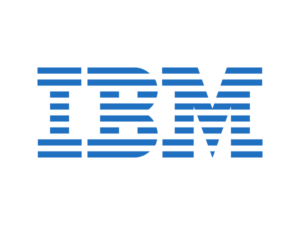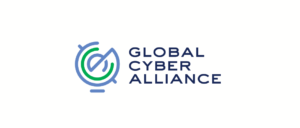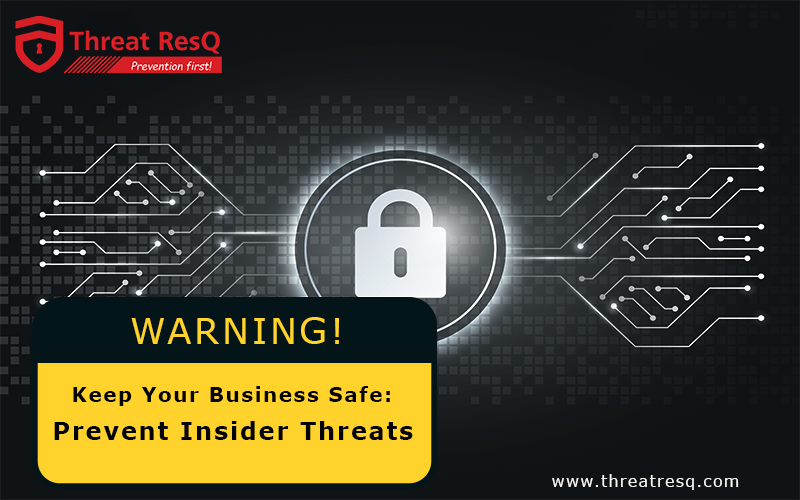
Common Sense Guide To Mitigating Cloud Insider Threats
- By admin
Insider Threat Risks You Need to Know in 2023
Introduction
As businesses continue to rely on digital technology for their day-to-day operations, the threat of insider threats looms large. Insider threats refer to security risks that originate from within an organization, whether intentional or unintentional, and can result in significant financial and reputational damage. As we enter 2023, it’s crucial for businesses to be aware of the latest insider threat statistics to better protect themselves from potential harm. In this blog, we will explore the key insider threat statistics that you need to know in 2023 to safeguard your business.
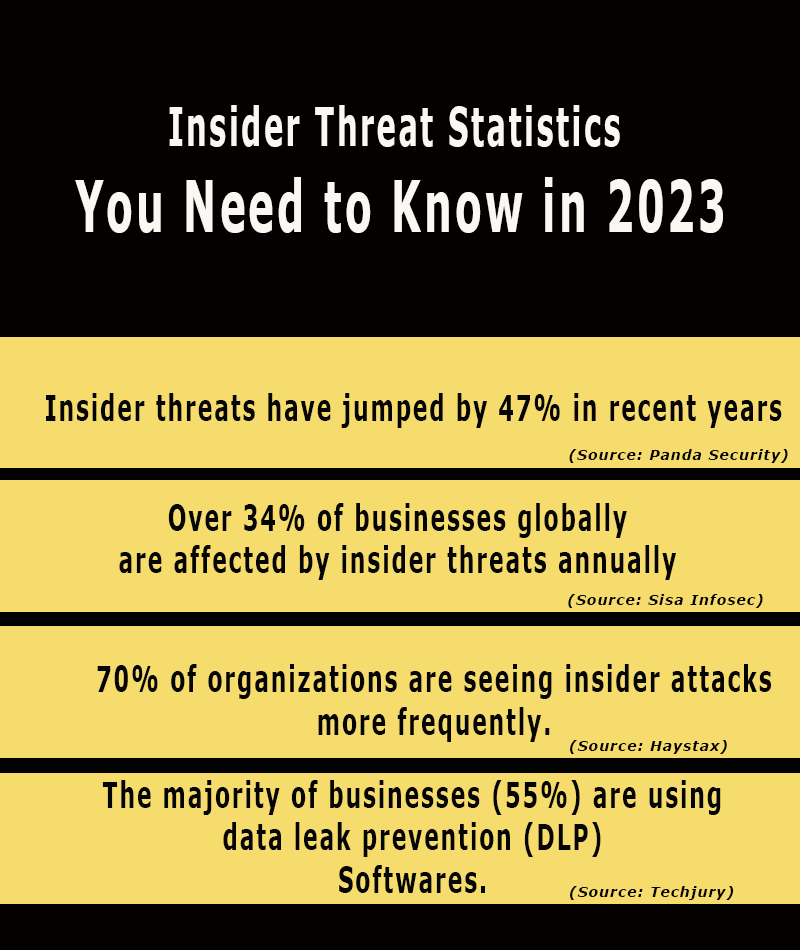
Types of Insider Threats
There are several different types of insider threats, including:
Malicious Insiders: This type of insider threat involves individuals who intentionally misuse their authorized access for personal gain or to harm the organization. This can include stealing sensitive data, sabotaging systems, committing fraud, or intentionally causing damage to the organization’s reputation or operations.
Careless Insider: Careless insiders are individuals who accidentally or unintentionally cause harm to the organization’s security or data due to negligence or lack of awareness. This can include clicking on phishing emails, misconfiguring systems, mishandling sensitive information, or using weak passwords, resulting in unintentional data breaches or security incidents.
Compromised Insider: Compromised insiders are individuals whose credentials or access have been compromised by external threat actors, such as through phishing attacks, social engineering, or stolen credentials. These individuals may unknowingly facilitate insider threats by inadvertently providing access to unauthorized individuals or systems.
Third-Party Insider: Third-party insiders are individuals who are not employees of the organization but have authorized access to the organization’s systems or data, such as contractors, vendors, or partners. These individuals may pose insider threats if they misuse their access or if their credentials are compromised by external threat actors.
Privileged Insider: Privileged insiders are individuals who have elevated access privileges within the organization, such as IT administrators or system administrators. These individuals may pose a higher risk of insider threats as they have more extensive access to critical systems and data, and their actions can have significant impact on the organization’s security and operations.
It’s important for organizations to be aware of these different types of insider threats and implement appropriate security measures, such as access controls, monitoring, employee training, and incident response plans, to mitigate the risks posed by insiders and protect their sensitive information and assets.
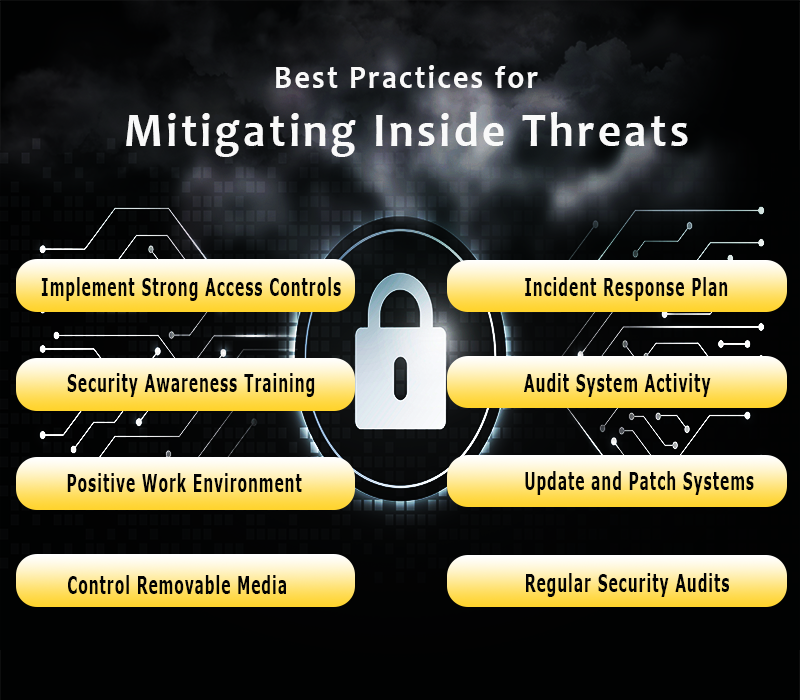
Some best practices to help mitigate inside threats in cybersecurity
- Implement Strong Access Controls: Limit access to sensitive data and systems only to those employees or contractors who need it to perform their job duties. Use role-based access controls (RBAC) to ensure that users only have access to the systems and data that are necessary for their job responsibilities. Regularly review and revoke access for employees who no longer require it.
- Conduct Employee Training and Awareness Programs: Provide regular cybersecurity training and awareness programs to educate employees about the risks of insider threats, including social engineering attacks, phishing, and malware. Train them on how to identify and report suspicious activities, and emphasize the importance of following established security policies and procedures.
- Monitor User Activity: Implement user activity monitoring solutions to track and analyze user behavior on critical systems and data. Monitor for unusual or suspicious behavior, such as unauthorized access attempts, data exfiltration, or changes to access permissions. This can help detect potential insider threats in real time and allow for a swift response.
- Enforce Least Privilege Principle: Follow the principle of least privilege, which means giving users the minimum permissions necessary to perform their job functions. Avoid providing excessive privileges that could potentially be misused by insiders. Regularly review and update user permissions to ensure they align with their job roles.
- Conduct Regular Security Audits: Perform regular security audits to identify vulnerabilities and weaknesses in your organization’s IT infrastructure, systems, and processes. This can help you uncover any potential insider threats or security gaps and take appropriate actions to address them.
- Enable Strong Authentication: Require strong authentication methods, such as multi-factor authentication (MFA), for accessing sensitive systems and data. This can add an extra layer of security and make it harder for insiders to gain unauthorized access to critical assets.
- Establish Incident Response Plan: Develop and implement an incident response plan that outlines the steps to be taken in the event of a suspected insider threat or data breach. This should include procedures for investigating and responding to incidents, including involving law enforcement, legal, and HR teams as necessary.
- Monitor and Filter Outbound Traffic: Implement outbound traffic monitoring and filtering to prevent insiders from exfiltrating data from your organization. Set up alerts for suspicious outbound network traffic patterns, such as large data transfers or communications with unknown or unauthorized external entities.
- Foster a Culture of Security: Create a culture of security within your organization by promoting cybersecurity awareness, accountability, and responsibility at all levels. Encourage employees to report any security concerns or incidents they come across, and provide them with the necessary tools and resources to maintain good cybersecurity hygiene.
- Regularly Review and Update Policies: Review and update your organization’s security policies and procedures on a regular basis to ensure they remain relevant and effective in mitigating insider threats. Keep abreast of the latest cybersecurity best practices and technologies and incorporate them into your policies as needed.
Conclusion
Don’t risk data breaches or accidental data loss that could have severe financial and reputational consequences. Contact us today to learn more about our DLP service and how it can benefit your organization’s cybersecurity posture!
With our Threat ResQ services, you can have peace of mind knowing that your organization’s sensitive data, such as customer information, financial data, intellectual property, and trade secrets, are protected at all times.




